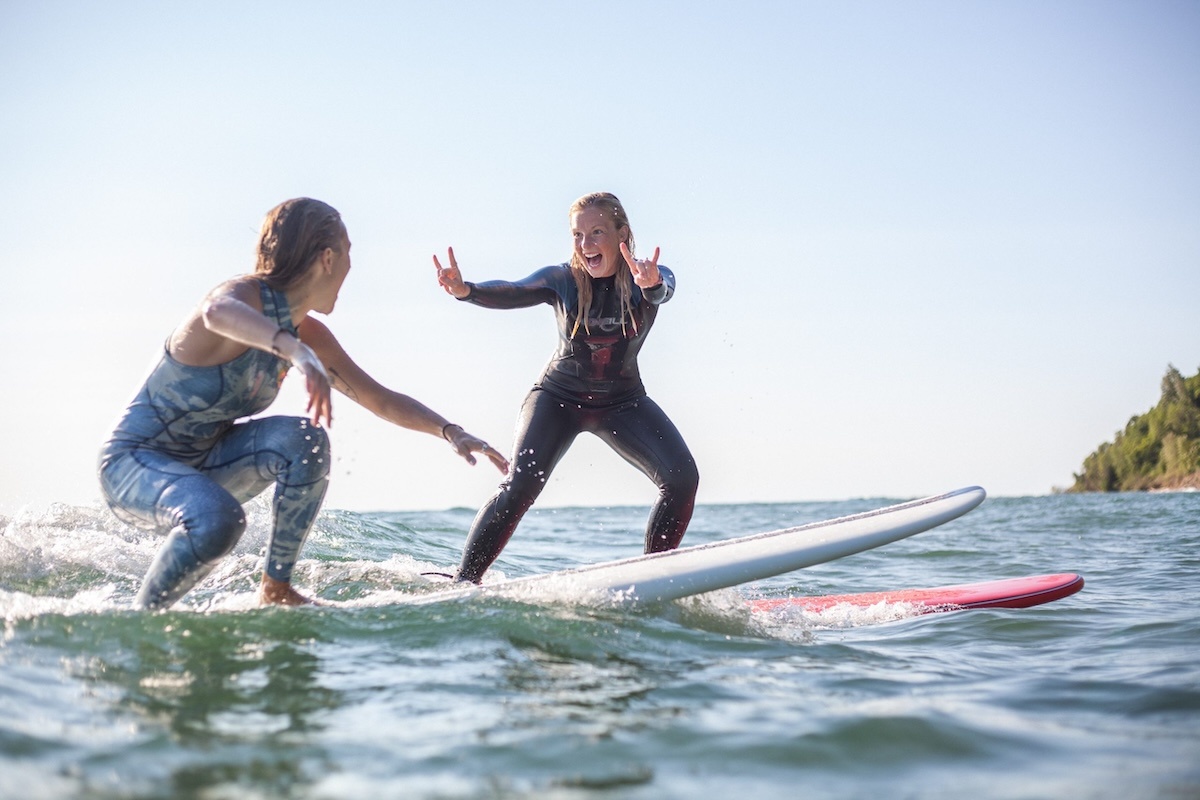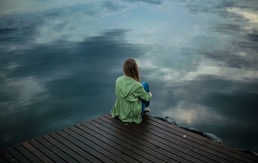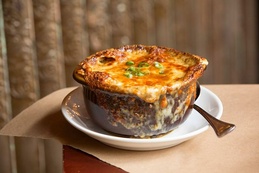
Fall Is for Surfing
Local surfers explain the thrill of Great Lakes waves
By Ren Brabenec | Sept. 6, 2025
September 2008 was a particularly challenging time for the building trades, as it coincided with the housing market crash. But renovations and construction projects never slowed down at Northport Point, and residents became used to seeing pickup trucks and vans parked along the Point’s narrow drives.
Only, that fall, a few of those work vehicles gained an odd accessory: surfboards.
“You can’t surf the Great Lakes,” residents would chuckle as they walked by. Flannel-wearing, bearded carpenters servicing the Point’s many cottages and cabins would smile and wave and get back to work, but as soon as the weather conditions they’d predicted would set in, they’d fly out of their work gear, don wetsuits, and take off, only to return hours later with even bigger smiles than they’d had on before.
Fast-forward almost two decades, and just about everyone knows you can surf the Great Lakes, and surfboards are no longer a rare sight but a staple feature of northern Michigan lakeshores.
Not a Passing Fancy
“I had the immense privilege of growing up on Lake Michigan,” says Ella Skrocki, owner of Sleeping Bear Surf & Kayak in Empire. “I was raised on the water amidst the heart of the Sleeping Bear Dunes, in precious little Empire, Michigan. It was there where I rode my first wave, on our 14-foot windsurfing board. As a family, we’ve always embraced the many moods of the Great Lakes, particularly when the wind is howling, and we utilized the gear we had to maximize fun and embrace the power of the big lake.”
To Skrocki, Sleeping Bear Surf & Kayak isn’t just the first dedicated northern Michigan surf shop. It’s a hub for the community, helping residents and visitors tap into the potential of Lake Michigan. Skrocki agrees that, when they first started, Great Lakes surfing was a foreign concept to most. Now, it’s not uncommon to see 40 to 50 surfers out in the water when the conditions are right.
“When we opened shop in 2004 there were just a handful of people riding waves,” Skrocki says. “Back then, we could have made boo-coo bucks if we collected a dime every time someone said, ‘You can’t surf on a lake.’ We still get that line, but more so in the form of a question, and significantly less often.”
She says the growing popularity of Great Lakes surfing is a reflection of how knowledge is spreading about the power of the lakes. “I hope that’s reflected in expanded water safety awareness, and therefore fewer drownings. And I hope that respect translates into care and a greater desire to protect the water. As my mama would say, ‘you care for what you love.’”
The surf community in northern Michigan has had a cumulative growth effect because, as each “newbie” has become enthralled by the sport, they inevitably get their friends into it, and soon entire social cliques become surf-obsessed. To Skrocki, this is nothing but good news, as long as the community continues to remain energetic, welcoming, humble, and respectful of the sacred spaces that are Michigan’s lakeshores.
“When you enter the lineup for the first time, or even when you’re pulling up to a spot, start a conversation with those that are there,” Skrocki advises. “Come with questions, an open heart, a smile, respect, and humility, and the freshwater surf community will take you under their wing and welcome you in as part of the family!”
Lake Surfing vs. Ocean Surfing
Most Michigan surfers have logged the majority of their surf hours on the Great Lakes, with occasional jaunts to far-off places for ocean surfing. Not so with Hans Pohai Müller.
Born in Hawai'i, Müller got on a surfboard when he was just six years old, and he immediately fell in love with the iconic swells of Oahu’s North Shore. With the exception of his stints as an expat (often in prime surfing locations, such as Spain’s Canary Islands), Müller has spent most of his life between Hawai’i and northern Michigan, bringing his knowledge of ocean surfing to the freshwater coast.
To Müller, people interested in the sport must learn the unique differences between lake surfing and ocean surfing, because knowledge of those distinctions won’t just make for a better surfing experience, but a safer one.
“Ocean waves originate from very distant, offshore storms,” says Müller. “That storm energy transfers into the water, creating what we call a groundswell. As the energy pushes through the water unimpeded, it creates waves that synchronize. As the waves approach land, the increasingly shallower water forces the swell upwards into the visible portion of the wave you see from shore.”
According to Müller, ocean waves (especially in Hawai’i) are quite predictable, they happen often, and their “wave period,” or length of time between waves, is much longer than on a lake.
“Typically, when you have a surfable wave on the Great Lakes, it’s because there’s been a strong wind that has blown across the lake for a couple hundred miles, as in the case of the Frankfort swell,” Müller says. “But it can be a strong wind blowing over a shorter distance, too. For example, Vans Beach in Leland is surfable when there’s been a strong north wind, but that wind is only blowing across maybe 50 miles of water before it hits the shore.”
To Müller, a “good” wave period on the Great Lakes is seven or eight seconds between waves, but it’s usually even shorter than that, which makes surfing the waves challenging at times. Compare that to the North Shore of Oahu, where the wave period can easily be 20 seconds.
Müller also reminds us that while our water may be unsalted and shark-free, it is far less buoyant than saltwater, so surfers have to work harder to stay afloat, maneuver, and catch waves.
Advice for New Surfers
Great Lakes surfing can look intimidating to the uninitiated, especially since some of the best surf conditions occur during intense storms and on cold autumn or winter days. To the surfers interviewed for this story, the following are the most important tidbits of advice for those new to the sport and for those coming from the ocean to try their hand at freshwater surfing.
Look for piers and jetties: “The search is so much a part of the experience,” says Skrocki. “Piers or jetties are where you’ll find the most consistent surf, and the most community. The spot is always so dependent on the wind direction, too. In the summertime, with a big ol’ south wind, catch us at the north side of the Frankfort Pier. Vans Beach in Leland is where we’ll be if the wind is out of the north.”
Study wind direction: “Frankfort has good surfing on a strong south swell,” said Matt Dursum, another surf enthusiast and a former Express contributor. “Waves form on the north side of the pier. The angle of the shore blocks south winds and grooms the lake. It gets big in November and peaks in early winter. This is the most consistent and popular wave in the area. Empire produces an easy wave that’s perfect for beginners. On its good days, the Empire swell becomes a long one that breaks near the dunes. Vans Beach in Leland is a popular place for more experienced surfers. The swells break on shallow sand and can deliver heavy sections.”
Talk to people who know the territory: “The number one tip with lake surfing is to talk to somebody who has a lot of experience doing it,” Müller emphasizes. “The beautiful thing about having Sleeping Bear Surf in Empire is there’s a community resource with truly generations worth of knowledge to tap into before one even enters the water.” (In addition to gear, Sleeping Bear Surf also offers surfing classes.)
Become informed on the nuances of freshwater surfing and get the right gear for it: “Learn about the hazards and currents that exist on the Great Lakes, dive into forecasting tools, and gain an understanding for the environment you’re itching to enter,” says Skrocki. “And get your hands on the proper gear! It’s so vital to have the correct equipment to keep you safe, warm, and having fun.”
Respect the water and use the buddy system: “The two biggest pitfalls I’ve seen among novice surfers, are, one, there’s not a great understanding of how difficult surfing can be, even if someone has skateboarded, snowboarded, or done a similar sport,” Müller says. “Your position on the board is always changing, and unlike skateboarding or snowboarding, the shape of the wave underneath you is always changing. The second factor is a lot of people underestimate how powerful the lakes are. For example, there are multiple drownings in Lake Michigan every year. Even before you get out there, have a good understanding of what the currents are, what to do in the event of an emergency, and always go out with a buddy.”
Photo by Liam Kaiser Creative, courtesy of Sleeping Bear Surf & Kayak
Trending

Anxiety, Screens, and Self-Esteem
If adulting feels hard sometimes, let it be a reminder that growing up can be, too. Data from the National Alliance on Ment… Read More >>
Gaming That’s Out of This World
Anyone with an appreciation for the late 1970s and 1980s might enjoy the sound of vintage video games and their incredible l… Read More >>
Finding True North
For most, the next step after graduating from law school and passing the bar exam is to join an established law firm. That&r… Read More >>


